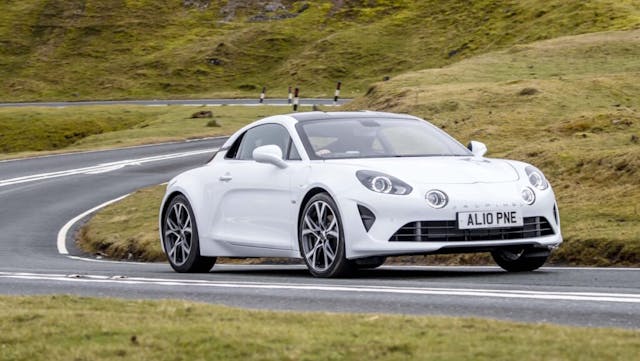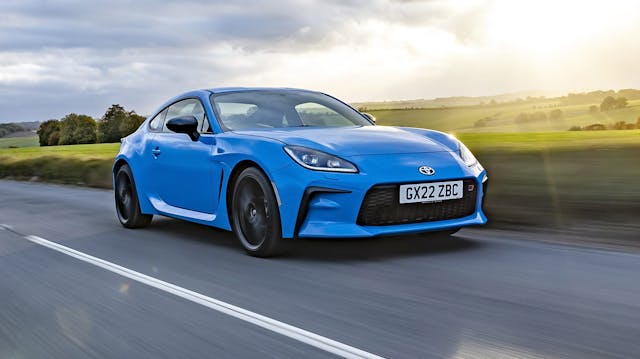Opinion: Bad tech is killing off great cars
No, the regulations discussed here don’t apply in the United States. (At least, not yet.) Beyond our desire to bear other enthusiasts’ burdens, and to help you be informed about the global situation, we want to share Mills’ piece with you because it illuminates why car manufacturers build the vehicles they do. (Or don’t.) It’s not just about the customer—it’s about the government, and profit. —Ed.
Please don’t take this the wrong way, but you’re stupid. It’s nothing personal, and you haven’t done anything wrong to deserve the label. And if it’s any consolation, you’re not alone; I’m a doofus too, and so is every other driver buying a new car.
The problem is—and please, don’t bother trying to persuade anyone otherwise—your eyes are failing you. Yes, you may have had an eyesight test just last week and yes, the optometrist may have declared that your eyes would be the envy of any seasoned bird watcher, but take it from those who know better, you’re a menace behind the wheel who couldn’t recognize a traffic light or speed limit sign even if it was mounted on the bonnet.
Then there are your reactions! A sloth could do a better job of steering around an obstacle in the road. As for stepping on the brake pedal, can you even be trusted to remember which out of no fewer than three pedals—three, I tell you!—applies the slowy-down things?
And let’s not get started on knowing your lefts from your rights, or raising the seat high enough to peer over the top of the steering wheel. As for the two second rule, well, you are that fool.
Face it: It’s time to hang up your driving gloves—whether a nicely aged stringback or metaphorical pair.

At least, that seems to be the attitude of our good friends at the EU. They’ve been busy for the past … oh, let’s see … 10 years or more working on the anonymously titled General Safety Regulations 2, the difficult second-album follow up to General Safety Regulations.
What’s that, you may ask? GSR2 sets out to make new cars safer, in part by ruling that all new cars launched after 6 July 2022, regardless of price or engineering suitability, have to come with intelligent speed assistance and emergency lane-keeping system, amongst a host of other active and passive safety features including data recorders. From July 2024, existing cars already in showrooms will have to be modified to include this safety kit to stay on sale.
Taken at face value, anything that can help prevent an accident and lower the rate of injuries and fatalities on our roads is a good thing.
Unfortunately, there are increasing numbers of reports of the technology going rogue. The Sunday Times, amongst others, has highlighted a surprising number of cases where intelligent speed-assistance systems have proved anything but clever, misreading a 30 mph sign for a 100 mph sign (which, no prizes for guessing correctly, doesn’t exist in the U.K.) and taking off like a scalded cat.
The idea is that, when active, the cruise-control-type system uses a camera to spot speed limit signs and adapt the vehicle’s speed to the local limit. Think of it as an extra pair of eyes for a driver.
Except, surely, it’s human nature for drivers to see this type of convenience as one fewer thing for them to have to think about?

And then there are the lane-keep assistance systems, which prompt the driver and can even steer a vehicle if they think it’s wandering from its intended path. These can work well on well-marked motorways or dual carriageways. But, although they can be switched off, I have lost count of the number of cars I have reviewed over the years where the system has been overwhelmed by simple things like an absence of road markings on country roads, or decided to perform an emergency stop because of the proximity of a car parked at the side of a bend or even because it was challenged by a simple dip in a road.
So the tech isn’t reliable, yet it has to be fitted to new cars sold in the E.U. and U.K. (which is following the E.U.’s timeline). It may lull drivers into a false sense of security and mean they pay that little bit less attention at the wheel. And it costs a small fortune.
That last point is as painful for drivers who want an affordable car as it is for car enthusiasts. Small, cheap cars have been killed off because fitting them with all the safety and emissions equipment means there’s no profit left in them. So affordable new cars are now a thing of the past—bye-bye Fiesta, for example. Meanwhile, the kind of cars that driving purists love to champion are also on the ropes.

The GSR2 rules apply to all the mainstream car makers, because the exemption volume that was agreed to by the E.U. is capped at a paltry 1500 cars across the EU. Autocar reports that this is a problem for the likes of Alpine. Its acclaimed A110 sports car—a bit of a slow burner if ever there was one—has just enjoyed its best year of sales since reaching showrooms in 2017, comfortably above that 1500-car limit.
Setting aside the question of whether or not the sort of people buying an A110 in the first place want active driver aids, it doesn’t make financial sense to re-engineer the A110 to include intelligent speed assistance and an emergency lane-keeping system. So Alpine will be forced to sell fewer of them in France and the U.K., and try its luck in markets where GSR2 rules don’t apply. And I think we can all predict how this will impact any potential replacement for the A110.

Even Japanese giant Toyota finds itself caught out by GSR2. Its GR86, one of the last relatively affordable fun driver’s cars money can buy, will have a comically short shelf-life of just two years because it’s built on the platform of the old GT86 and can’t be cost-effectively adapted to accept the safety kit.
Even as law makers add more safety kit to new cars, though, U.K. road fatalities have been static for the past decade.
In case you hadn’t guess it, GSR2 is the E.U.’s path to enabling fully driverless vehicles, and while I’m still to meet anyone who tells me they can’t wait for the arrival of autonomous cars, nothing but nothing is going to stand in the way of the rule makers who have decided we’re too stupid to drive.
Check out the Hagerty Media homepage so you don’t miss a single story, or better yet, bookmark it.



Ever have snow or mud piled on your car so that, even when swept off, it clings to small nooks and crannies? Ever have several large bugs (e.g. – grasshoppers) strike the front of your vehicle s you drive – splattering in spots from under the chin to all over the windscreen? Now, where do you suppose the automakers have to place a camera or sensor in order to detect upcoming speed limit signs or obstacles?
If you guessed that all of these questions meet at an answer that produces the possibility that sensors and/or cameras might be partially or even totally obstructed by common items hitting them while you are driving, then be sure you ask the sales person at your dealership how the heck this vehicle he/she is trying to sell you will know what to do if (when!) it happens.
“Small, cheap cars have been killed off because fitting them with all the safety and emissions equipment means there’s no profit left in them. So affordable new cars are now a thing of the past”
Annnnd this is why we’re seeing more and more used enthusiast cars hit staggeringly high prices at auctions.
This may sound a bit cold, but I don’t know if anyone has noticed, but there are 8 billion people on earth. 8 billion. To put it into perspective, there were 4 billion people on earth when I was born, and I’m not really all that terribly old. This ‘let’s make things safer and remove all risk from life’ approach that we seem to have thrown at everything is probably going to eventually lead to some fairly cataclysmic problems if we don’t engage the automatic braking system soon
Cold, TG? How about this for cold? We’re making “survival of the fittest” a passe term. Soon there will be no more fittest. And even the weakest will survive, because some technology will take care of all their needs.
Regulations are the reason we no longer have cheap cool enthusiast cars, and nobody ever brings them up. This article is way past due.
Regulations’ impact on the enthusiast car market pale in comparison to those from the general apathy among able buyers and the narrow profit margins enthusiast cars have. Doesn’t help that dealers also slap on ridiculous ADMs and then wonder why no one buys enthusiast cars anymore. Ford didn’t kill their car lines because of regulations, they killed them because of profit and demand.
Is it not a chicken/egg situation? How do know the regulations, which make the cars more boring, aren’t killing demand?
The cold harsh reality is we are far from being over crowded. Just get away from the coast and we have miles and miles and miles of nothing
The plan in the future is to control all aspects of out lives. We see it every year at the WEC meeting with ideas and plans they come up with.
The self driving is all about control on where you go when you go and how you go. They can dictate where you can travel, what way you get there, the time you can travel and how fast you get there.
This will be in the name of climate control, safety and over crowding.
They already have smart electric meters to control the use of electricity. We have wifi thermostats that could be centrally controlled as to how warm or cold you will be.
I am not a conspiracy guy and I never though that big brother would gain control but I listen to these future planers and see the tech that we are getting and they very well can gain control of us in a number of ways.
This can turn out to be a very bad real life sifi movie.
We are now seeing breath analyzer being required on cars soon. My GMC now tells me the speed of the road. How long till they put the control on the electric throttle that will not let me go over the speed limit.
I have blamed Air Bags and helmet laws for the problems we are having today. In the past these folks were the ones who used to off themselves and not we are protecting them and they are reproducing.
We have messed with nature to thin the heard.
Back in pioneer times only the sharpest survived. The guy who thought he could as Custer though did not survive to get elected.
Your GMC also maybe reporting your driving habits back to your insurance company.
You see, just like your web browsing data, your driving habits are big dollars to advertisers, insurance companies, and municipalities.
All this insidious spy/control tech is why both my modified Holden/Pontiac GTO and modified Chevy Tahoe are 2004 models. This is the last year I feel comfortable tampering with or replacing the ECU and/or sensors, and really, pretty much the last generation of computery hocus pocus I truly understand. I’ll give up some small efficiency gains and “safety” nannies so I can actually drive and maintain/modify MY- not the government’s- vehicles. Recently had a 2023 Toyota Corolla rental; a nice and inoffensive transportation appliance, but most of the doo dads and electronic babysitters I defeated if possible. I wonder what this basic sedan is going to cost maintenance wise around 10-12 years from now for the 4th/5th owner, when all that tech starts glitching or flat failing. I think I’ll keep my old guys til infirmities or death stop my driving- at least I know I will be the one in control!